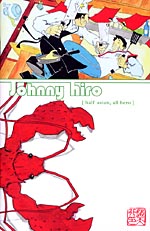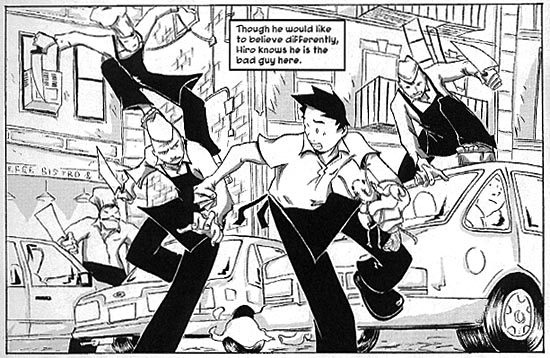 By Fred Chao
By Fred Chao
32 pages, black and white
Published by AdHouse Books
Every now and then, I hear people talking about the idea of going away from single issues of comics (in favor of strictly longer-form graphic novels) and I think to myself, “Would that really be such a bad thing?” What always makes me come to my senses, though, is coming across a comic that uses the single-issue format perfectly. And so, with that in mind, another book to add to that list is Fred Chao’s Johnny Hiro, one that can best be summed up as 32-page bursts of sheer fun.
Johnny Hiro and his girlfriend Mayumi live blissfully in New York City. She has an office job, he waits tables. Life is pretty good so long as nothing is thrown into their path. Unfortunately, sometimes there’s just no escaping those obstacles, like Gozadilla (a city-destroying monster) or Jeffrey Steingarten (food editor of Vogue magazine). And so, with no other choice, Johnny Hiro must be… a hero.
With just two issues of Johnny Hiro published to date, what impressed me right off the bat was how Chao has managed to both mix things up from one issue’s story to the next, and yet still provide a cohesive feel and tone to the series. The first issue, with its Godzilla-esque monster and giant-robot-riding flashbacks, runs rampantly into the world of science-fantasy, a trippy and over-the-top romp through movie clichés and tropes. The second issue’s plot, then, may have been a bit of a surprise to readers with a story about trying to obtain a lobster so a restaurant could impress a food critic, firmly rooted in reality. What both of these issues have in common, though, is their general attitude and approach to how the story unfolds. There’s a certain lightness about them, a lack of taking things too seriously. Chao has fun as he puts Hiro through the wringer, flashing back to the past, pulling in family members, occasionally even noting the silliness in what’s going on.
Chao also has a sharp narration style, mixing in pop culture references and internal musings of the characters in a way that never feels intrusive or forced; it all flows very naturally in such a way that the book would be radically different without it. It works especially well when Chao dwells on Hiro and Mayumi’s relationship, one of the centerpieces of the series. I really like reading about their caring for each other; it’s a realistic kind of relationship, one that is neither smothering nor disregarding the other half. While we’re still learning a lot about both of them, they’re already coming across as two genuine, believable characters. As much fun as the action sequences are in the series (and Hiro’s run across the city in the second issue was a real joy to read), I think it’s their relationship that is my favorite part of the series.

Chao’s art in Johnny Hiro is an interesting mixture of simplicity and detail, one that mirrors the different sides of his writing. We’ve got faces here with little dots for eyes and a squiggle for a smile, but you turn the page and find a beautifully rendered drawing of Kannon, the Japanese goddess of mercy. Some pages are full of cityscapes with rowhouses and trash cans and bunny slippers, others dispense entirely with backgrounds in favor of graytones as to let you focus more on the action in the foreground. It was with the second issue, though, that I really started to notice Chao’s ability to draw action sequences. The panel of Hiro running out of the restaurant with a stolen lobster while the chefs leap after him is wonderful, because you can just see the energy in that single, frozen image. Likewise, Hiro jumping up towards a fire escape ladder—complete with action trails behind him and a spa-kashh sound-effect—contains a lot of movement even in its slightly goofy nature. It’s a fun, slightly whimsical art style, and that in many ways is the perfect description of Johnny Hiro.
Reading each issue of Johnny Hiro reminds me that bigger isn’t always better; while I have no doubt that Chao could certainly create an excellent graphic novel with the character, for now I think it actually works better in this format. 32 pages is just the right amount for a short story involving Hiro and Mayumi’s latest adventure; it never overstays its welcome, and concludes still feeling fresh and fun and with the reader wanting to see more. Definitely take a look at Johnny Hiro, because if you haven’t looked at it because of its format, you really are missing out on a great thing. More, please.
